Better Content Leads to Better Operational Outcomes
Critical policies and procedures must be clear, concise, and easy to access to be effective.

Three Mile Island is the site of the worst commercial nuclear accident in US history. In 1979, the nuclear power plant had a partial meltdown and released radioactive gasses into the atmosphere in south central Pennsylvania.1
The disaster started with malfunctioning water pumps that helped to cool the radioactive fuel in the reactor core. Plant employees didn’t realize the reactor was experiencing a loss of coolant and that the reactor was overheating.1
An investigation into the incident concluded that inadequacies in equipment design, information presentation, emergency procedures, and training caused the human error that was experienced that day.2 Confusing and ambiguous control room indicators, coupled with poor training and deficient procedures, led to a misunderstanding of the reactor’s status.
Some of the specific conclusions of the investigation stated:
- The procedure for how to deal with this incident was found to have a detailed assessment of their “Loss of Reactor Coolant/Reactor Coolant System Pressure” procedure, which revealed serious deficiencies in content and format.
- There was little consistency between nomenclature used in procedure documents and that used on panel components.
The investigation reported that “information required by operators is too often non-existent, poorly located, ambiguous, or difficult to read.”
While it’s unlikely your documented procedures, job aids, work instructions, policies, and training processes will lead to an accident on the level of Three Mile Island, they are critical for your frontline teams’ ability to deliver on goals. Content and format matter because it’s the information your teams turn to for clear expectations on routine and complex procedures alike. It gives your employees the tools they need to do their jobs right the first time and also to respond when something goes wrong.
Clear communication ensures everyone is on the same page and working toward the same goal. Following the best practices laid out below will help you create content that resonates with and adds value to your team members who are using it.
Audience
The most important thing to consider when developing content is who will be using it, where they’ll be, and how they’ll access it.
- Will they be on the plant floor using a tablet?
- Will they be on the phone with a customer?
- Will they be on site at a client location?
Considering their context will help you tailor the content to them so it’s easy for your employees to find the answers they need when they need it. If a document title doesn’t match their expectation or the information they’re looking for is buried in the middle of a long document, they may give up.
Think about how your team members will access your documents. If they’re accessing content on a phone or picker device, scrolling will be a lot more difficult. If you know they’ll be on a tablet or laptop, you may be able to get away with more. In most cases, if you create content with mobile-first in mind, your content will also be easy to use on a desktop device.
| Dos 👍 | Don’ts 👎 |
| Write short titles Five words in a title should suffice. And because of the way we scan content, people end up reading the first and last three words. So, most of your headline ends up being read. | Don’t use complex words It’s all about economy when creating content for mobile devices. The fewer and simpler the words, the smoother the reading experience. For example, – require – needs – request – ask for – discontinue – stop – due to the fact that – because – reach out – contact |
| Test it first It’s easy to consider what a document will look like if accessed on the same device you’re using to create it. Always, always preview on a small screen before going live with content. If you’re working on a laptop, you can preview mobile by resizing your browser to the size of a phone. | Don’t go on and on If a document is too long, mobile users won’t be able to find the information they need. Breaking up content into multiple documents or introducing white space can help. |
| Chunk Present related content together in small chunks. Headlines, summary/description, steps, multimedia can all help with this. | Don’t add horizontal scrolling Creating multi-level lists can require horizontal scrolling on mobile devices and smaller screens. Break up the content into more bite-sized chunks. Also, avoid tables wider than three columns. |
| Be sensitive to file size Mobile users may have a weak internet connection. When possible, convert attachments to native Acadia documents for optimal sizing and viewability. | Don’t put too much text on images Annotated images can be helpful for many purposes, but too much text on an image makes it harder to use. Consider that people will have to pinch and zoom content on images. |
| Avoid uploaded files Consider that users will have to pinch and zoom native Word and PDF files. Warn users if an attachment couldn’t be converted. |
Search
When creating content for teams to search and find, it’s important to understand what document properties will affect its searchability. Regardless of what system you use to store content, you want it to be easy to find. You’ll be limited by the search capabilities of the platform you’re using, so you’ll want to understand what those are. All content in Acadia, for example, can be found with a Google-like search engine.
In general, there are good rules of thumb to follow:
Search algorithms may give greater weight to certain fields than others. For example, a search algorithm typically presents results based on the quantity of similar matches in each field of a document. The more frequently a search term is used and the higher importance of the field (title, description, section titles, uploaded attachments, etc.), the higher the document will appear in search results. Certain fields have a greater search impact than others so it’s important to take advantage of this knowledge when adding keywords to your content.
Name your documents and title steps using the words your team would search. Avoid uncommon, technical jargon in high and medium search impact fields. For example, if everyone knows a procedure as “Sweeping the Floor,” avoid a title like “End of Shift Dust Retrieval Process.”
Findability
Make sure your team can find the content you’ve worked so hard to produce. The easier it is to find documents, the more likely your team will be to use them.
How can you tell if your team is having trouble finding a document or not even looking for it?
- The same mistakes are being made for policies or procedures related to the document.
- People complain they don’t have the right information.
- Team members are still asking a lot of questions and not grasping information related to your documents.
Keywords
- A search term included in a title will appear higher in search results than that same search term used only in the body content of the same document.
- If the same search term is used in the title AND the body, it will appear higher still.
- Adding your most important search terms/keywords to more than one of your content’s fields will give your document greater weight in search results and make it easier for your audience to find.
When determining which keywords to use, consider your audience. You don’t want to select keywords that will be unfamiliar to them or that they wouldn’t consider using to search for content.
If you aren’t sure what words your audience uses, ask them!
Digestibility

Finding the right document is just the first step in connecting your team with the content they need.
Sometimes what they need is in the middle of a document. Regulatory requirements or complex processes may make your content long, dense, and difficult to consume. Unfortunately, these are all things that work against your purpose of providing the right information to the right person, at the right time. You can help by making the content easier to consume “at-a-glance.”
Short & Concise
Start by saying more with less. In other words, make your documents easier to read by making each part shorter and more concise. Cut the fluff and say the same thing with fewer words.
Here are some tips:
- Use clear, concise language
- Keep sentences short and actionable
- Break long content into segments
- Avoid long paragraphs of text
- Use lists for sequential steps
Consistent Styles
Establish a style guide that can help your team of content creators and subject matter experts consistently deploy style tools. Consistent style execution will help your readers learn how to skim your documents faster.
Apply styles like subtitles, color highlighting, and even all caps consistently to help your team find important information across all documents. But use any style sparingly. Too many text styles and highlights make it hard to focus.
Considerations for your style guide:
- Limit ALL CAPs for abbreviations and other rare instances – ALL CAPS ARE HARD TO READ AND TEND TO GENERATE MORE ATTENTION THAN WAS INTENDED
- Highlight items with color if the color conveys a message – use color for things like safety risks, levels of security, or other items of importance
- Use bold type to create sub-headings within documents – bolding text can help people skim content by focusing attention on the items in bold instead of reading everything
(Notice how hard it is to focus with all the text styles and highlights in the bulleted list. This is a great example of what NOT to do.)
Multimedia
Where possible, replace long text descriptions with videos, diagrams and other media. Images draw attention and provide breaks in content. People process information in different ways. Providing content as text, supported with graphics and video will help the widest possible audience.
Anchor Tags
Navigation tools, like anchor tags in a document, will also help your audience navigate content more easily. Anchor tags allow you to create a hyperlink to a location in the same page, so readers can jump from the top of a document to a critical or frequently used section within the document body. They also help readers skip to a different part of a document based on the outcome of a procedure step. This strategy is often used for troubleshooting.
Accessibility
Our team members come from many backgrounds and with different abilities. Your content should be helpful and usable for all of them – regardless of their ability to see, hear, move, or learn.
In many ways, systems are designed to automatically deliver optimization for people of all abilities. Acadia, for example, is designed according to Web Content Accessibility Guidelines (WCAG) and is compliant with the American with Disabilities Act (ADA). And while these guidelines are designed to support people with disabilities, they actually help make things easier for everyone to use.
As you build content, it’s important not to add elements or styling that would impede any team member’s abilities. Here are a few best practices to help.
Language Barriers
Acadia is also designed to support multiple language. Even if you’re only operating in the US, you might still need to eliminate the language barrier. Today’s access to a global talent pool means that most businesses will increasingly include employees whose first language isn’t English.3 This presents unique challenges and opportunities.
As American workplaces become increasingly diverse, translation plays an important role. Providing job aids, work instructions, and other critical documents that have been translated into the native language of your teams can help reduce errors and improve safety, efficiency, and compliance metrics.
Color
Color is an effective way to convey meaning and functionality, but it shouldn’t be the only way. People who are color blind or have low vision may have difficulty reading your content depending on color contrast ratios and font size. In general, accessibility guidelines require you to use more than just color to indicate meaning or functionality. You don’t have to avoid using color altogether; in fact, you should continue to use color to reinforce meaning and functionality. But don’t rely on color alone.
Images
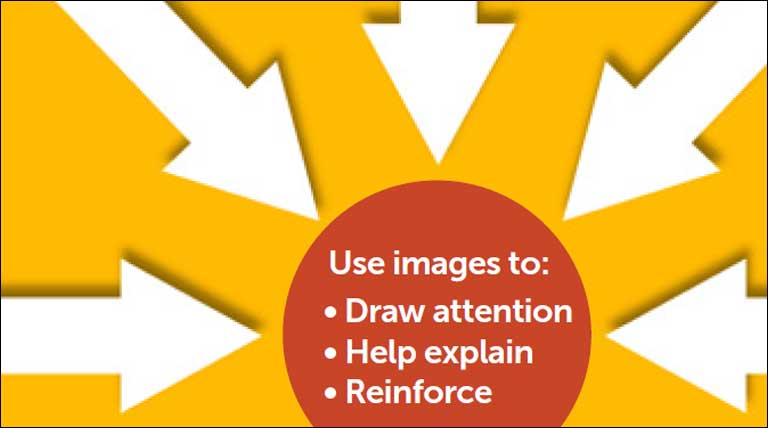
Use an image to enhance your text, not to be your text. It’s helpful to include arrows and call out text to images to help indicate activity. But screen capturing large portions of text from another document will prevent some team members from getting the message. Screen readers typically won’t read images. Some systems may automatically adjust text for different screen sizes, but the text on an image will not be adjusted. The text in an image won’t be “searchable,” either. Include descriptive alternative text for images. Because screen readers won’t read text on an image, the alternative text or description appears as an attribute of the image that a screen reader can read in place of the image.
Captioning
Team members who are blind or have low vision, and those who are deaf or hard of hearing are not able to access or experience videos unless they are made accessible. Include captions in video content to ensure they can be used by all.
Headings
Structure helps create meaning. This is true for all users, as well as non-human agents like screen readers and search engines. One of the main building blocks for structuring your content is the use of headings.
- Headings create visual structure
- When someone glances at a page, they should get a general sense of how it’s organized just by sight alone
- You know your headings are working if you put them in a list and they read like an outline of the information covered on that page
Reading Level
One of the WCAG – AAA requirements is to meet a middle school reading level for content. Many people bristle at the idea of “dumbing down” their content to a middle school reading level. However, when it comes to readability, reading level does not correspond to the actual education level of your audience.
Research indicates that people better comprehend and retain content when it is presented in simple terms. Even if your team members have advanced degrees, they shouldn’t need one to read your content.
When in doubt, use clarity, conciseness, and consistency. There is a huge overlap between best practices for accessibility and best practices for content development in general. All people benefit from writing that considers these best practices.
Mobile Content
Your audience may not always be sitting at a desktop or laptop, so it’s important to make your content mobile friendly.
Some systems, like Acadia, are developed with responsive design for optimal viewing on any device. Responsive design adjusts website content and layout automatically to fit your screen size, platform, and orientation. So, whether you’re viewing it from a laptop, tablet, phone, picking scanner, or any other internet enabled device, your content will be easy to read and use. If you’re working with a responsive web application, you’ll notice they are faster and easier to update than mobile apps.
Updates to the system are made seamlessly without the need to update mobile app software.
Responsive Website
- All devices with internet access, and a browser
- Doesn’t require download and installation to update
- Updates and bug fixes made seamlessly
Mobile App
- Only smartphones and tablets and dependent on operating system
- Requires downloading and installation
- Updates and bug fixes are only fixed when updates are applied locally
Content Governance
Content governance is the big-picture management of content across your organization. It’s how the norms, policies, guidelines, and actions for managing your organization’s critical knowledge are applied, reconciled, and enforced.
Governance is a critical component to your knowledge management strategy. No governance means leaving important details to chance. Too much governance means clogging the system and slowing everyone down. By establishing a framework for content governance, your team can strike the right balance to keep content current and valid to help those it’s created for.
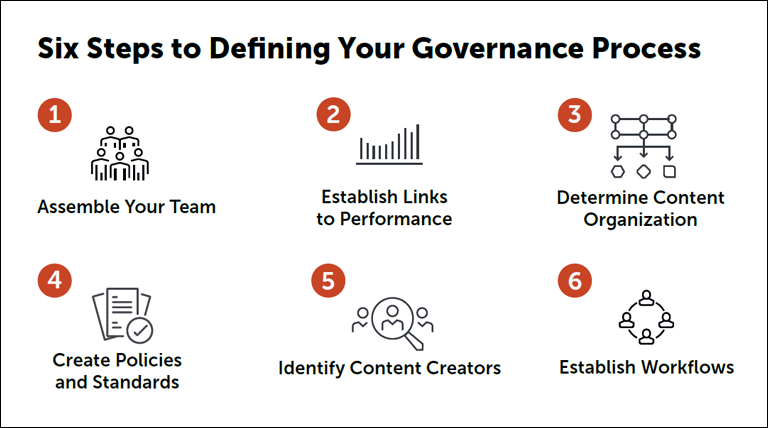
Step 1: Assemble Your Team
Since process and policy content is a company-wide initiative, you’ll want to find stakeholders and subject matter experts throughout the organization who can own the responsibility of creating and approving content. You don’t have to map the entire organization at once! For the specific content you’re creating, identify the stakeholders — it’s likely the business owner of the group you’re building the content for. Follow your organization’s structure.
Other key stakeholders can include legal counsel for regulatory-driven policies, safety leaders for processes that include safety guidelines or equipment, and IT leaders for procedures that guard against cyber-security risks. Each of these individuals should be responsible for giving final approval of content based on their role.
Subject matter experts (SMEs) are also critical to your content governance process. These are the people who know the processes and policies better than anyone else. They may have authored previous versions, led training exercises on the topic, or just simply do the work every day. They’ll help you identify things that you may have missed. They’ll also help you keep it realistic and easy to consume on the job.
Your team should be large enough to represent each of these stakeholders, but small enough to conduct effective deliberations. Once assembled, it’s important to clearly define roles and responsibilities. Your documents can drown in review if every person nit-picks every comma. Make sure everyone sticks to their functional lane.
Your Governance Team should also play a role in determining how frequently content should be updated. Some content is evergreen and can be reviewed once per year. Other content may need to be updated more frequently.
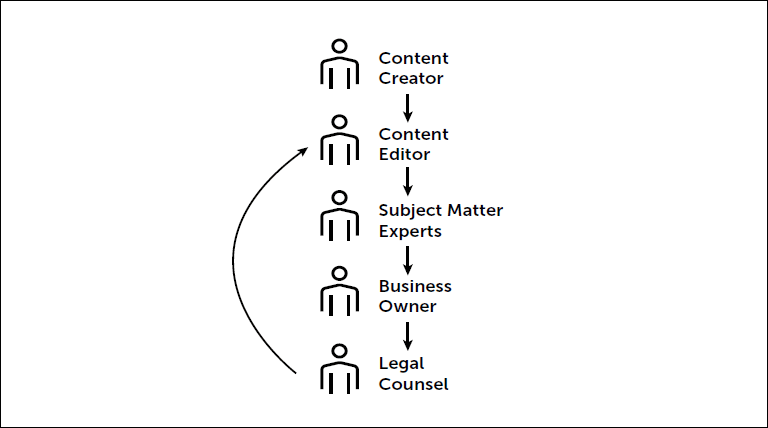
Don’t forget backups! Vacations and leaves of absence can mean your critical procedure sits idle for long periods of time. Ensure each team member has selected an alternate to step in when they’re not available.
Step 2: Establish Clear Links to Organizational Performance
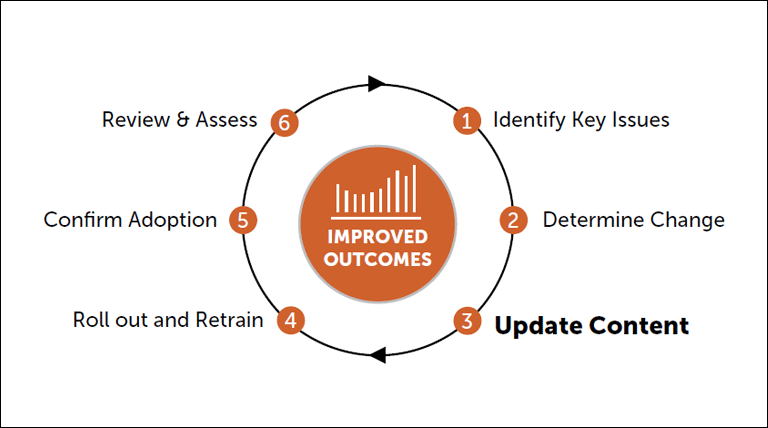
You’ll want to measure the success of the content you’re producing. Otherwise, you’ll have no idea if all your efforts have made an impact. Typically, the business leader requesting the content can help you determine which KPIs or metrics are relevant to the policy or procedure.
You may be tempted to use a metric like how many times a document was accessed. But this metric alone can be a bit misleading. An accessed document isn’t necessarily used or understood. Instead, choose a metric that’s important to the business. Some good examples are:
- Audit scores
- Customer experience scores
- Line yield
- Safety incidents
Correlating performance metrics with your document usage will show you what’s working and what’s not. You’ll know which employees might need more training and what documents may need to be edited.
Step 3: Define How Content is Organized
When organizing your content continue to keep your audience top of mind, as described above. When you know your audience, you can group content. Try to identify content that makes sense together.
Are there a bunch of income tax-related documents or maybe information on how to answer customer complaints? Are there location-specific documents? You may have machines specific to your Topeka location that need different work instructions than the machines at your other locations. Group those together so employees at the Topeka location can easily filter for them. Similarly, if a safety procedure at a warehouse in Quebec is different than the one in San Francisco, group their documents by locale. This way your teams don’t have to sift through documents unrelated to their function to find what they need.
You may be able to get even more specific by organizing documents by team and role. Distributing documents by role and location helps team members perform simple searches and retrieve the exact document they need in seconds. You can strategically remove complexity that helps support your organization at the most local level.
Step 4: Create Content Policies and Standards
This is where you define the “big picture” details of your content strategy. Bring your content team together to discuss issues that will come up during content creation. Decide how to handle them now to ensure your documents are cohesive.
Standards to consider:
- Identify your audience: WHO will be using your content
- Establish keywords and terms to use across content that they would use
- Establish style guidelines: Who is the content for and how will they access it?
- Standards for document titles
- Style consistency (when to use bold/italics/highlighting)
- Things to avoid like walls of text and text as images
- When and How you’ll use videos, diagrams, and other media
- What reading level should content be written for
- Account for accessibility
Take your team members’ input and synthesize the information to find the best possible standards. Then create a “Document Standards Guide” for all contributors to reference.
Step 5: Decide who Creates the Content
Just as you’ve identified who approves the content, it’s important to determine ahead of time who will create it.
You may have a dedicated team of internal content developers. Or you may appoint SMEs who know the processes best.
For instructional content, SMEs may be able to provide the most accurate procedures and have the best insight into task lists. For regulatory content, you’ll want someone who can write about it from a legal standpoint.
If you expect to receive a lot of requests for content, you may want to establish a process for submitting/approving content requests. Who should people send requests to? Who decides if the content is needed or relevant? How do you determine if the content already exists?
Step 6: Create Pragmatic Workflows
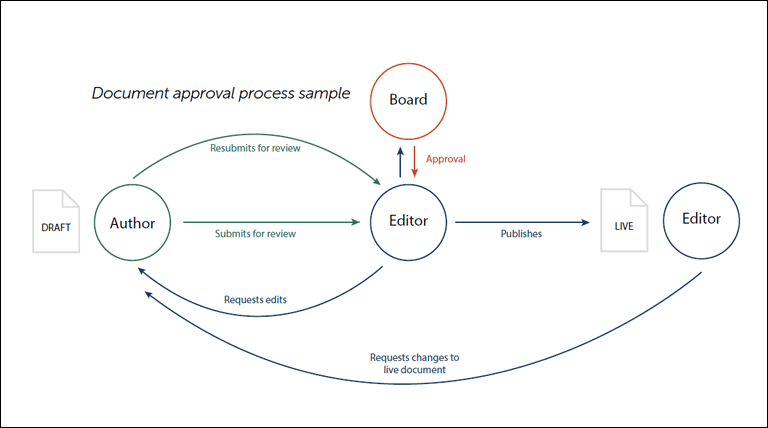
Develop workflows for approving content: document approval processes, quiz & task list review processes,[CP1] archiving, KPI/metrics reviews, and so on.
Workflows include content development and editing, as well as final steps for review and sign off from relevant members of your board before it’s published. Be as thorough and streamlined as possible to save yourself delays and rework in the future.
Enterprise vs. Location-Specific Content
While developing content, it’s important to identify what should be covered by broad enterprise policies, and what flexibility should be given to each region or location to control their own content. Otherwise, you may find that you’re sending mixed signals to employees.
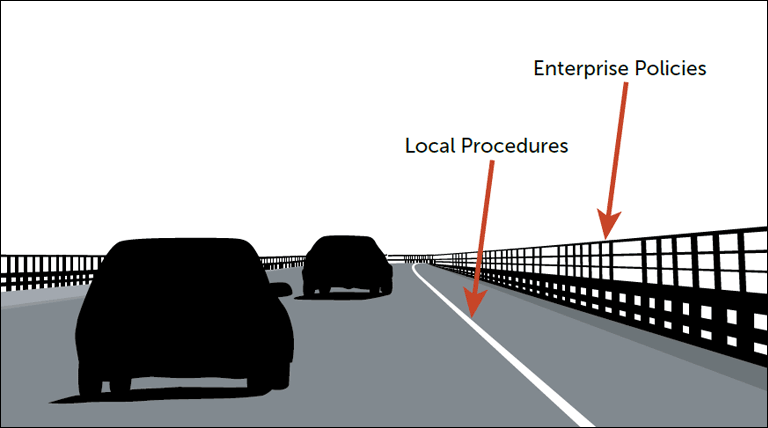
Enterprise-level content should be viewed as guardrails. These policies and procedures provide the ethical and aspirational borders that everything else operates within.
Local content is tethered to the realities on the ground. Local policies and procedures must follow local regulations and physical constraints while obeying the guidelines set by the Enterprise. It’s important that the two types of content do not conflict with one another.
As you build out corporate and local documents, consider how easy they are for employees to use and understand. Do your local policies and procedures act as an extension of the enterprise materials, or do they conflict?
The table below includes examples of how local policies might conform to or conflict with enterprise policies.
| Operational Area | Enterprise Policy Example | Conforming Local Example | Conflicting Local Example |
| Safety | Every employee must wear a hard hat, safety glasses, and ear plugs while operating any filter machine. | ✔ Every employee at the London facility must be equipped with a hard hat, safety glasses, ear plugs, and steel-toed boots to operate the filler machine. | ❌ Every employee at the Bruges facility must be equipped with a hard hat and safety glasses to operate the filler machine. |
| Security | At least two employees must be present when the vault is locked at every branch location. | ✔ A manager and one other associate from the Baltimore Inner Harbor branch must be present to close and lock the vault at the end of each business day. | ❌ A manager can close and lock the vault at the end of the day by themselves. |
| Regulatory | All customers must be notified of and given the right to have their data erased. | ✔ All organizations handling the data of customer within the European Union must adhere to the General Data Protection Regulation (GDPR), including the erasure of information or “the right to be forgotten.” | ❌ All customer data must be stored for seven years before being erased, even if it is no longer necessary. |
| Professionalism | All office employees must wear black pants and white shirts. | ✔ All employees in the Cincinnati office must wear black pants and white shirts that are tucked in. | ❌ All employees in the Orlando office may dress casual on Fridays. |
It’s important to include experts from your organization who can look at content development strategically and involve them in the content approval process.
Consider establishing a Center of Excellence to help with location-specific content. They can be responsible for meeting at a set interval to review global standards and best practices for your organization. With their local expertise, they can help develop a framework for local regulations and universal standards.
Appointing an Executive Sponsor can also help. Identify someone who understands the implications of corporate policies. HR, legal, or business leaders operating across regions can help you think through how content will scale and align with broader corporate policies, KPIs, and regulations.
Get Started
Creating content for your teams can seem like a big undertaking. That’s because it’s important. Whether you’re transforming old content to meet the needs of today or looking for best practices for creating content for the individual, you want to connect your teams with the content they need. But you don’t have to go at it alone.
Our Client Success Managers support our clients through all of the concepts you’ve just read about.
If you’re interested to learn more about Acadia and getting the best content into the hands of your frontline teams, contact us today.
Sources:
Ready to crush your goals?
"*" indicates required fields


